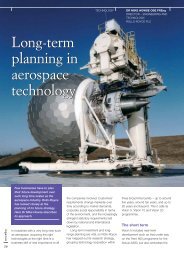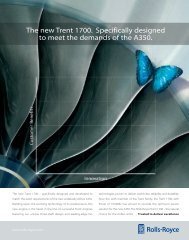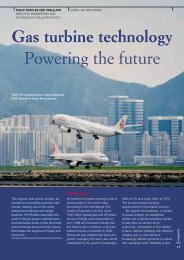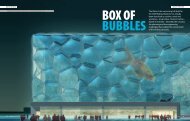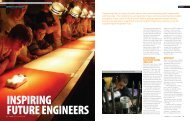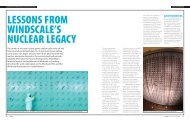Shipping safety - Ingenia
Shipping safety - Ingenia
Shipping safety - Ingenia
You also want an ePaper? Increase the reach of your titles
YUMPU automatically turns print PDFs into web optimized ePapers that Google loves.
MARINE MATTERS<br />
improvements they have made to ship<br />
<strong>safety</strong>, the International Association of<br />
Classification Societies (IACS) continues<br />
to be widely criticised, to the extent that<br />
calls have arisen recently for an<br />
independent ‘super IACS’ to pool the<br />
best talent. IACS suffers from lack of<br />
effective leadership (the Chairman<br />
changes every year) and is still too<br />
reactive and inward looking.<br />
The importance of public<br />
confidence<br />
The loss of public confidence always<br />
arises when major incidents and loss of<br />
public life occur, like the Titanic (1912)<br />
and the more recent ro–ro ships Herald<br />
of Free Enterprise (1987) and the<br />
Estonia (1994). Moreover, you cannot<br />
insure against loss of public confidence.<br />
Should this happen, for example, in the<br />
rapidly expanding cruise ship market<br />
(which has had a 60% growth in the<br />
last ten years), there could be a major<br />
downturn in the market.<br />
It is precisely for such reasons that<br />
the very near loss of the specialised<br />
Antarctic cruise ship Bremen in the<br />
south Atlantic in February 2001 has<br />
been kept under wraps. She was<br />
struck by a monster wave over 30 m<br />
high; the small cruise ship Caledonian<br />
Star (March 2001) was caught in similar<br />
circumstances. Three other much larger<br />
cruise ships have been similarly struck<br />
by abnormal waves in recent years and<br />
detailed circumstances were generally<br />
withheld as only two passengers were<br />
lost overboard. ‘Near misses’ such as<br />
these should receive full attention and<br />
research study as is done in the aircraft<br />
industry.<br />
The ro–ro ship Estonia’s rapid loss<br />
with 852 lives in September 1994<br />
caused public concern and justifiable<br />
fears about the rapidity of the final<br />
capsize and the inability to evacuate the<br />
passengers in the statutory time of 30<br />
minutes (see The Royal Academy of<br />
Engineering news release of 6 January<br />
1995). The official investigation report<br />
has been widely criticised and it seems<br />
the most likely cause of the loss has<br />
not been properly established – a not<br />
uncommon failing of official reports.<br />
The mammoth cruise liners of today,<br />
accommodating up to 4,000<br />
passengers, could not be evacuated in<br />
30 minutes if there was danger from fire<br />
or sinking. Cruise passengers at large<br />
are doubtless unaware of these<br />
incidents and facts, and it seems that<br />
public confidence in cruising has so far<br />
not been dented. The <strong>safety</strong> of many<br />
thousands of people who daily use<br />
ferries is also at stake. Ferry speeds are<br />
increasing, which escalates the risks.<br />
Moreover, there is also a wider<br />
public concern which needs to be<br />
remedied regarding oil pollution, mainly<br />
from tanker spills. The general tolerance<br />
of governments and of the public to<br />
accept pollution has evaporated.<br />
Reduced pollution, of course, is also<br />
directly linked to improved shipping<br />
<strong>safety</strong>. Stena Line’s answer to stop<br />
pollution is seen in Figure 4. This shows<br />
a giant 358,000 m 3 capacity tanker of<br />
70 m beam whose <strong>safety</strong> features<br />
include double hull construction and,<br />
for breakdown redundancy, twin<br />
independent engines, twin propellers,<br />
steering gears and rudders. It can also<br />
maintain 6 knots on one engine in force<br />
8 head seas.<br />
Figure 4: Stena Vision is<br />
designed for<br />
anti-pollution<br />
and <strong>safety</strong><br />
Recent actions and<br />
improvement suggestions<br />
The International Maritime<br />
Organization<br />
The IMO is the international body<br />
responsible for <strong>safety</strong> of life at sea<br />
(SOLAS Convention) and has over 150<br />
member states. Under the inspired<br />
leadership of William O’Neil CM FREng,<br />
its Secretary General, IMO recognises<br />
some of the above weaknesses and has<br />
recently implemented several measures<br />
aimed at reducing human errors in ship<br />
operation. Most notably they include the<br />
International Safety Management (ISM)<br />
code and the Standards of Training,<br />
Certification & Watchkeeping (STCW)<br />
convention. The industry seems to be<br />
responding reasonably well to the<br />
additional paperwork and to the<br />
inevitable teething problems.<br />
At present IMO is also very<br />
concerned with bulk carrier <strong>safety</strong>. It is<br />
introducing a formal <strong>safety</strong> assessment<br />
(FSA) approach to ship design and<br />
operation, starting with bulk carriers. It<br />
seems to follow on similar lines to the<br />
practice in the offshore industries. The<br />
author used an FSA approach for the<br />
forensic analysis of the loss of the<br />
Derbyshire and has suggested<br />
guidelines for use when investigating<br />
ingenia<br />
17



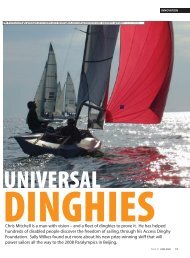

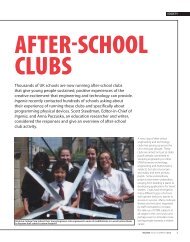

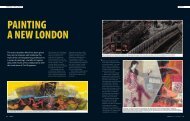
![[322/03] Francke - Ingenia](https://img.yumpu.com/23411337/1/184x260/322-03-francke-ingenia.jpg?quality=85)

